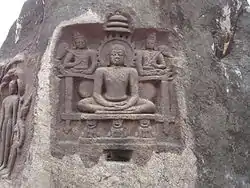| Mahavir Janma Kalyanak | |
|---|---|
 Vardhaman Mahavira image at Keelakuyilkudi, Madurai, Tamil Nadu, India. | |
| Official name | Mahavir Janma Kalyanak |
| Observed by | Jains |
| Type | Religious, India (national holiday) |
| Significance | Birth Anniversary of Mahavira |
| Celebrations | Going to the Jain Temple |
| Observances | Prayers, religious rituals |
| Date | Chaitra Sud Triyodashi (teras) (Vira Nirvana Samvat) |
| Frequency | Annual |
| Part of a series on |
| Jainism |
|---|
 |
Mahavir Janma Kalyanak is one of the most important religious festivals in Jainism. It celebrates the birth of Mahavira, the twenty-fourth and last Tirthankara (supreme preacher) of present Avasarpiṇī.[lower-alpha 1] On the Gregorian calendar, the holiday occurs either in March or April.
Birth
According to Jain texts, Mahavira was born on the thirteenth day of the bright half of the moon in the month of Chaitra in the year 599 BCE (Chaitra Sud 13).[1][2] Most modern historians consider Kundagram (which is today's Kundalpur in Muzaffarpur district of Bihar) as his birthplace. Mahavira was born in a democratic kingdom (Ganarajya), Vajji, where the king was chosen by votes. Vaishali was its capital.[3] Mahavira was named 'Vardhaman', meaning "One who grows", because of the increased prosperity in the kingdom at the time of his birth.[4] In Vasokund, Mahavira is revered by the villagers. A place called Ahalya bhumi has not been ploughed for hundreds of years by the family that owns it, as it is considered to be the birthplace of Mahavira.[3]
Legend
Mahavira was born into Ikshvaku dynasty as the son of King Siddhartha of Kundagrama and Queen Trishala. During her pregnancy, Trishala was believed to have had a number of auspicious dreams, all signifying the coming of a great soul. Digambara sect of Jainism holds that the mother saw sixteen dreams which were interpreted by the King Siddhartha.[5] It is said that when Queen Trishala gave birth to Mahavira, Indra, the head of heavenly beings (devas) performed a ritual called abhisheka on Sumeru Parvat, this being the second of five auspicious events (Panch Kalyanakas), said to occur in the life of all Tirthankaras.[6]
Celebrations


The idol of Mahavira is carried out on a chariot, in a procession called rath yatra.[7] On the way stavans (religious rhymes) are recited.[8] Statues of Mahavira are given a ceremonial anointment called the abhisheka. During the day, most members of the Jain community engage in some sort of charitable act, prayers, pujas, and vratas. Many devotees visit temples dedicated to Mahavira to meditate and offer prayers.[9] Lectures by monks and nuns are held in temples to preach the path of virtue as defined by Jainism. Donations are collected in order to promote charitable missions like saving cows from slaughter or helping to feed poor people. Ancient Jain temples across India typically see an extremely high volume of practitioners come to pay their respects and join in the celebrations.[10] Ahimsa runs and rallies preaching Mahavira's message of Ahiṃsā (non-violence) are taken out on this day.[11][12][13]
References
- ↑ (India), Gujarat (1975). Gazetteers: Junagadh. p. 13.
- ↑ Kristi L. Wiley: Historical Dictionary of Jainism, Lanham 2004, p. 134.
- 1 2 Jalaj 2011, p. 4.
- ↑ Kailash Chand Jain 1991, p. 32.
- ↑ Pannalal Jain 2015, p. 460.
- ↑ Pramansagar, Muni (2008), Jain tattvavidya, India: Bhartiya Gyanpeeth, p. 30, ISBN 978-81-263-1480-5
- ↑ "Piety marks Mahaveer Jayanthi". Deccan Herald. 3 April 2015.
- ↑ "Both sects of Jain community take out attractive joint procession". Archived from the original on 6 April 2015.
- ↑ "Mahaveer Jayanti 2015: The importance of a Satvik meal", NDTV, 2 April 2015, archived from the original on 4 April 2016
- ↑ "How and Why Mahavir Jayanti is celebrated". India Today.
- ↑ "Jain youth to hold vegan promotion rally on Mahaveer Jayanti in pink city Jaipur". merinews.com. 28 March 2015.
- ↑ "Jains gear up for Mahaveer Janma Kalyanak tomorrow". dnaindia.com. 1 April 2015.
- ↑ Staff Reporter (30 March 2015). "Over 900 run for spreading Bhagwan Mahaveer's message". The Hindu.
Notes
- ↑ descending half of the worldly time cycle as per Jain cosmology which is actually current now
Sources
- Jain, Kailash Chand (1991), Lord Mahāvīra and His Times, Motilal Banarsidass, ISBN 978-81-208-0805-8
- Jain, Pannalal (2015), Uttarapurāṇa of Āchārya Guṇabhadra, Bhartiya Jnanpith, ISBN 978-81-263-1738-7
- Jalaj, Dr. Jaykumar (2011), The Basic Thought of Bhagavan Mahavir, Mumbai: Hindi Granth Karyalay, ISBN 978-81-88769-41-4